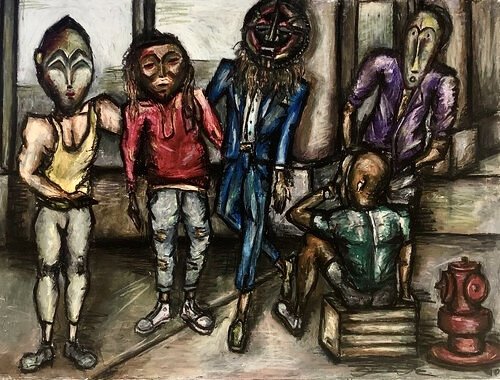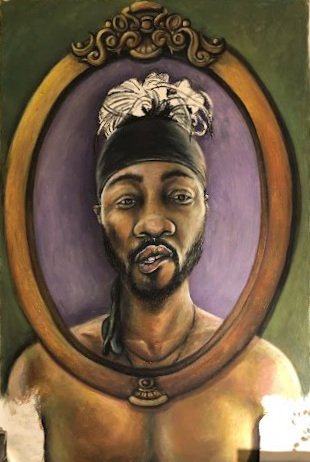SHORT DESCRIPTION
“Lost Boy” is a figurative examination of the African American Male. Blending the glamorized beauties of the European Academy, with the spiritual & ancestral works of African art, this series investigates the deeply rooted connections that shaped the conception of African Americans. Civilized/Savages, Colonizer/Colonized, Slaver/Enslaved, American/Negro …
Juxtaposition
Technique and Subject matter
Using a natural color palette and variety of workable surfaces, I look to give my work a realistic look that documents accurately materials often used by sculptors, potters, jewelers, and mask makers. Materials such as wood, glass, clay, stone and gold are all achieved through a mixture of experimentation and prior knowledge. Many works adopt techniques used in classical European oil painting. a minimalist approach is reflected in my selection of materials. they include minimal acrylic paint, colored pencils, oil pastels, and gold leaf, but I pull inspiration from the works created during the renaissance, the baroque period, and even pop art.
Juxtapose are the African American subjects I focus on in the work. Each blended with a variety of African art influences not found in classical European art. This blend of style and subject matter speaks to the domination of classical techniques and practices in art education, as well as the domination of whiteness in the field of art. Throughout my process I use my fine arts knowledge, creative materials and experimental techniques to achieve works that blur the line between crafted mask and realistically modeled skin.
Each of my lost boy works is an active creation with little planning but a real attention to the development of the form on the surface. Playing with light, I allow it to dance back and forth across the surface of the figure as it pleases. Moving the face forward and back in space, as I blend the flesh through a fusion of colors.
Each Lost Boy is a unique blend of black facial features and elements influenced by African art and mask. Special attention is given to the eyes of each of my lost boys to both emphasize their gaze and invite you in.
THE TITLE
“LOST BOY“
The origin of the title “Lost boy” is linked to a variety of interesting and interconnected themes and topics. Through research, reflection and meditation I was able to better understand the themes I choose to address within my artwork. Each Lost boy is ancestral, contemporary and post-contemporary. These mask-like figures are a blend of the traits and characteristics found in African art, and the faces of contemporary African Americans, descendants of these people.
Like masks found in cultures around the globe, these masks are a bridge to my ancestors. They reveal the faces of the descendants of boys stolen from their homes, forced to endure labor and all that followed to bring us to this present moment. I seek to represent this lineage through The faces of the contemporary African Americans depicted in my work.
Similar to Picasso’s views, after seeing the African mask for himself, These lost boy works are a visual manifestation of ancestral terrors, as well as future desires for justice in the present and future.
creative process
This collection of work is the result of years of studying the figure and color theory. It pulls together my experiences in using a wide variety of materials, applying my learned techniques and knowledge to produce work I thoroughly enjoy creating.
On December 31st 2019, I started the piece entitled “Black Boy Joy”(F1). The concept was my first attempt at blending contemporary western style figures with elements of African art. I was largely inspired by the artist Pablo Picasso and his work “Les Demoiselles d'Avignon”(F2) of 1907.
My work borrows the composition, along with other elements from this piece by Picasso. My goal in creating this work is to first reflect on the lives of the past, then to comment on the present and last, create conversations to better our future. This was the beginning of the concept I now call post-contemporary.
In his original work Picasso paints five prostitutes, all cramped into a tight composition. Their naked bodies are fragmented into large sections and planes. Picasso also adorns his figures with African masks, breaking even more from the traditional nudes we are use to. Prior to the creation of this work, Picasso visited a collection of African mask and said this:
“I forced myself to stay to examine these masks. All these objects that people had created with a sacred magical purpose, to serve as intermediaries between them and the unknown hostile forces surrounding them, attempting in that way to overcome their fears by giving them color and form, and then I understood what painting really meant. it’s not an aesthetic process, it’s a form of magic that interposes itself between us and the hostile universe. A means of seizing power by imposing form on our terrors as well as on our desires. The day I understood that I had found my path.”









